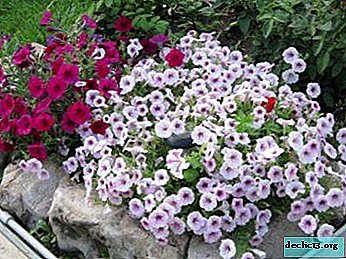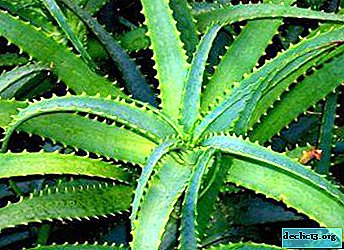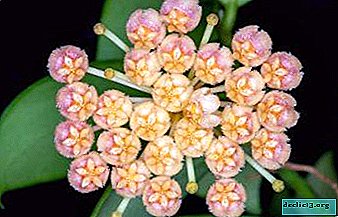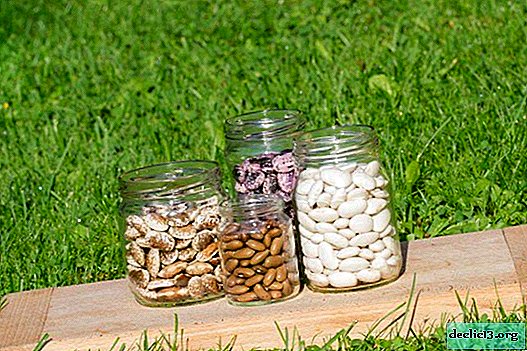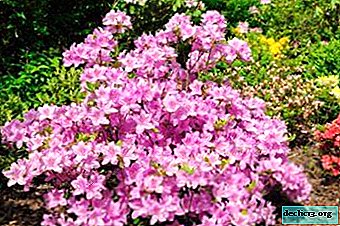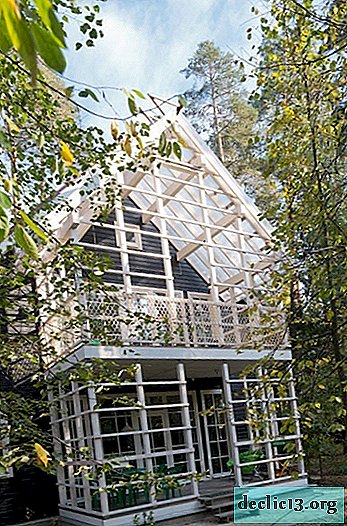A noble variety of Anthurium Black Prince: complete information for lovers of exquisite plants
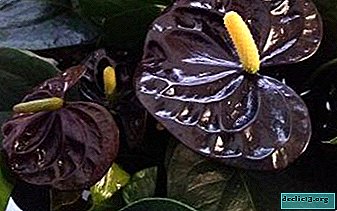
Anthurium The Black Prince is the most refined and noble variety of Anthurium. A luxurious bush looks contrasting among other indoor flowers, adding a noble color and colorfulness to any home flower garden.
In the article we will consider this flower, read its description and see how the plant looks in the photo. We also learn how to care for anthurium, what diseases and pests affect it.
Botanical description and Latin name
Anthurium The Black Prince, Black Queen - a hybrid variety of the genus Anthurium of the huge Aroidae family (Araceae). In total, natural species number up to 900 specimens. This perennial decorative flower belongs to the tall species of anthurium.
The scientific name Anthurium means tail and flower.. In everyday life, flower growers call the plant "male happiness," "flamingo flower." The Black Prince variety has the synonymous name Black Queen.
History of occurrence and geography of habitat
Austrian botanist G. Schott in the 19th century first classified the genus Anthurium. Later, in the 20th century. The German botanist G. Engler introduced substantial changes in the composition of this genus. In 1983, the Croatian scientist Schaeffer divided the varieties of Anthurium into 19 separate sections.
Anthurium Black Prince is a variety of large-leaved large-bred varieties. The natural habitat of the flower is rocky terrain, rocky mountains, tropical forests of South America, Colombia and Ecuador.
Description of appearance and photo
Variety feature - one bush gives flowers in black and red shades - the result of crossing two separate varieties (about what varieties of black anthurium are and how to care for them at home, read here). The height of the bush reaches 70 - 80 cm. Inflorescence - the ear at the very beginning of flowering has a white or beige hue. Later, the ear becomes light green in color.
The bedspread is spacious, heart-shaped, up to 12 - 15 cm in length. Bract - the cover is brilliant, the surface is streaked with relief veins. At the beginning of flowering, the buds have a cherry hue, then the veil darkens, acquires a rich black color with a burgundy red tint.
The leaves are dark green, leathery in structure, slightly elongated, have a heart shape. The length of the leaf plate is up to 30 cm, width is 20 - 25 cm. Petioles are straight. Peduncles straight, dense, formed in the axils of the leaves.
Below we will see this flower in the photo:



How to care at home?
Temperature
The heat-loving Anthurium Black Prince feels good in the summer at a temperature of 20 - 25 ° C. In the autumn months, the air temperature should be lowered to 12 - 15 ° C.
Watering
In spring and during flowering, watering should be regular, 2 - 3 p. in Week. It is better to water the plants in the morning so that the water is well absorbed into the soil.
Important: young plants require more frequent soil moisture. Adult plants are watered after the top layer is slightly dry.In hot weather, a spray and shower should be added to maintain a balance of air humidity. Watering should not fall on the flowers themselves. It should be watered only with clean and warm water. Immediately after watering, the water must be drained from the pan. To reduce air temperature and increase humidity, open containers with water or wet moss are placed next to the pots.
Shine
Direct sun is not desirable for this flower. Pots are best installed on the windows of the western and eastern parts of the house. South windows should be shaded in summer.
The flower is afraid of drafts, cold air flows from the window and air conditioning.
Priming
 You can use the finished mixture for aroid, adding the missing components. The soil should be light, loose, it is important to add drainage from pieces of expanded clay, pieces of brick, and crumb foam to the composition of the mixture.
You can use the finished mixture for aroid, adding the missing components. The soil should be light, loose, it is important to add drainage from pieces of expanded clay, pieces of brick, and crumb foam to the composition of the mixture.
Soil composition:
- Charcoal - 1 hour.
- Coarse sand - 1 hour.
- Pine bark (pieces of medium size) - 1 hour.
- Moss-sphagnum - 1 h.
- Humus - 1 hour
- Sheet land - 1 h.
- Drainage.
Pruning
Trimming the bush should be done only in early spring in order to rejuvenate adult plants. Truncated lateral shoots and apical stems are used for reproduction.
Trimming Procedure:
- Cut off the dead dead leaves.
- After flowering, wilted buds are removed.
- When transplanting, rotten and dry processes of the root are cut out.
- The side stems are carefully separated together with part of the root system.
- The top of the stems is cut off.
Top dressing
To stimulate the formation of buds, maintain the brightness of flowering, Anthurium Black Prince should be fertilized regularly from March to early September. Top dressing is carried out once a week.
 Experts recommend using ready-made complex fertilizers:
Experts recommend using ready-made complex fertilizers:
- "Forte" for indoor plants, the composition of the drug includes magnesium, succinic acid.
- "Bona Forte", series No. 1, No. 2. The composition includes a complex of organic and mineral fertilizers.
Top dressing is used for watering and spraying. Doses are observed according to the instructions.
You can prepare fertilizers yourself:
- 1 tsp potassium sulfate in 2 to 3 liters of water.
- 1 tsp preparation "Agro-school for flowering plants" in 2 liters of water.
- 0.5 liters of fermented mullein per 10 liters of water.
Fertilizers are recommended to alternate.
After the transplant, flowers should be fed after 2 weeks. Sick plants do not fertilize.
Pot
It is better to use clay pots, they absorb moisture better. The pot changes with every change. The size is selected in accordance with the volume of the root system. Capacity should not be very large and deep.
For outflow of water and air permeability at the bottom of the pot must be done several holes.
Transfer
Young plants grow more intensively, so you need to transplant them every year. Adult bushes plant less often, 1 p. in 2 to 3 years, as the roots fill the tank. Transplantation is carried out in the spring, using the method of transshipment.
Transplantation scheme:
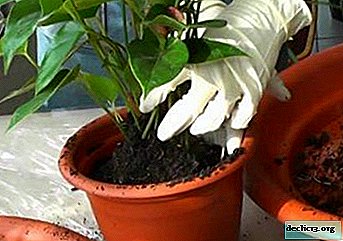 The pot flips to one side.
The pot flips to one side.- The flower is carefully removed along with an earthen lump.
- Rotted roots are cut.
- Places of slices are sprinkled with crushed coal.
- Drainage is poured at the bottom of the pot.
- The root gently drops, the processes evenly fit into the container.
- The pot is filled with soil.
- The top layer is lightly tamped.
- Above, the soil is mulched with moist moss.
- The watering mode is normal.
Wintering
The optimum air temperature in winter is -12 ° C. The flower does not withstand sudden changes, cold wet content. In cool conditions, the dosage and watering regimen are reduced. It is enough to water the flowers once a week. Instead of spraying it is better to wipe the leaves from dust with a damp cloth.
Lighting needed bright. You can move the pots to the south side or add artificial lighting with special lamps for several hours a day. Daylight hours in the winter months should be at least 8 hours.
Important: to stimulate flowering in January, increase the air temperature to 20 ° C. In spring add “hot” watering (water temperature up to 30 - 35 °).During dormancy, soil should be fertilized once every 2 weeks.
Propagation Features
Shanks and side stems
The easiest way to breed:
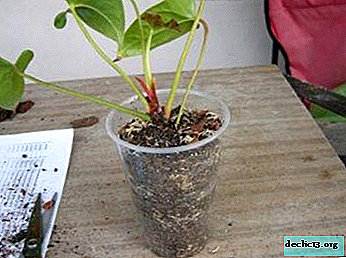 When transplanting, side shoots are separated along with the roots.
When transplanting, side shoots are separated along with the roots.- The separated shoot is transplanted into a small container.
- The top of the stems is cut off along with the internodes (2–3 nodules) for cuttings.
- In a spacious container, cuttings are deepened by 1 cm.
- The greenhouse is covered with a film.
- Rooting takes place within a month.
- Seedlings are transplanted into separate pots.
Seeds
The method is inconvenient and lengthy. Hybrid varieties do not retain varietal characteristics in seeds.
- Seeds before planting are soaked in a solution of manganese. Germinate seeds can be on wet foam.
- Then they are distributed on the surface of the wet substrate. Greenhouse conditions are required.
- After 4 weeks, seedlings dive into plastic cups for growth.
Diseases and Pests
- From stagnation of water, cold and lack of light, the root and stem is affected by rot. Mold appears on the leaves. Cropping required. Transplant with a complete replacement of the soil.
- From anthracosis, septoria (yellow spots on the leaves) will be saved by spraying with fungicides. It is necessary to adjust the watering and access of light, the plant is quarantined.
- Processing a bush with tobacco infusion will help get rid of orange aphids.
- To prevent damage by pests and viral infections, it is recommended to treat the flower with phytosporin once a season.
Similar flowers
- Calla Black Crusader. The shiny coverlet is slightly twisted, it has a blackish tint.
- Calla Black Forest. The bedspread is a richly violet sail. Along the very edge is a white border.
- Calla Black Pearl. The bedspread has an open bedspread of a deep purple hue.
- Calla Black Star. The bedspread has the shape of a tulip, the color is purple-black.
- Calla Maron Sensation distinguished by a brilliant veil of ripe cherry with a blackish tint.
Despite the "royal title", the Anthurium Black Prince is quite unpretentious and hardy. With proper care, it grows quickly and multiplies easily at home.

 The pot flips to one side.
The pot flips to one side. When transplanting, side shoots are separated along with the roots.
When transplanting, side shoots are separated along with the roots.